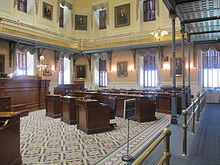South Carolina Senate
| South Carolina State Senate | |
|---|---|
| South Carolina General Assembly | |
 |
|
| Type | |
| Type | |
|
Term limits
|
None |
| History | |
|
New session started
|
January 10, 2017 |
| Leadership | |
|
Majority Leader
|
|
|
Minority Leader
|
|
| Structure | |
| Seats | 46 |
 |
|
|
Political groups
|
Governing party
Opposition party
|
|
Length of term
|
4 years |
| Authority | Article III, South Carolina Constitution |
| Salary | $10,400/year + per diem |
| Elections | |
|
Last election
|
November 8, 2016 (46 seats) |
|
Next election
|
November 3, 2020 (46 seats) |
| Redistricting | Legislative Control |
| Meeting place | |
 |
|
| State Senate Chamber South Carolina State House Columbia, South Carolina |
|
| Website | |
| South Carolina State Senate | |
Governing party
Opposition party
The South Carolina Senate is the upper house of the South Carolina General Assembly, the lower house being the South Carolina House of Representatives. It consists of 46 senators elected from single member districts for four-year terms at the same time as United States Presidential elections.
The South Carolina Constitution of 1895 provided for each county to elect one senator for a four-year term. The election of senators was staggered so that half of the state Senate was elected every two years. After the U.S. Supreme Court ruled in 1964 for the case Reynolds v. Sims, the state Senate was reapportioned in 1966 as a temporary measure into 27 districts with 50 members for two-year terms. In 1967, the state Senate was again reapportioned, this time into 20 districts with 46 members for four-year terms. The number of districts was reduced to 16 in 1972 and in 1984, they were eliminated with the creation of single member districts.
The annual session of the General Assembly convenes at the State Capitol Building in Columbia on the second Tuesday of January of each year. However, after convening, either the House or the Senate may call for itself a 30-day recess by a majority vote, or a longer recess by a two-thirds vote.
Except as noted, all Senators were elected in November 2016. All terms expire in November 2020.
(a) The election of a Democrat from Abbeville was declared void and the seat remained vacant.
(b) All 7 were members of the Conservative Party of South Carolina.
(b) All 7 were Independent Democrats.
(d) After the 2000 elections, the Senate was evenly split between 23 Democrats and 23 Republicans. A Democrat, J. Verne Smith of Greer, switched to the Republicans to break the tie.
(e) Republicans gained an additional seat in a 2007 special election.
...
Wikipedia
